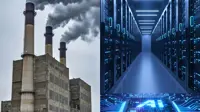Gartner, WWF assess low carbon and environmental leadership among global ICT companies
05 Nov 2008
Gartner, Inc., today presented the results of an assessment of 24 global information and communication technology (ICT) providers on their commitment to tackling climate change within their own company and their capabilities in innovating and developing solutions that will help them and their clients thrive in a low carbon economy.
The assessment was carried out in partnership with the World Wide Fund for Nature (WWF).
The survey revealed the emergence of several low carbon ICT leaders that are innovating in environmental and climate leadership and other providers that are maintaining the status quo. However, the assessment showed that the ICT industry overall has been slow to embrace the low carbon economy despite the tremendous opportunities that will be presented to the industry, such as smart buildings and grid applications and travel substitution.
Simon Mingay, research vice president at Gartner, presented the findings of the Gartner and WWF's assessment of global low carbon leadership of the ICT industry during Gartner Symposium/ITxpo 2008, being held here through 7 November.
''This is a unique industry report the first of its kind that examines the commitment of large ICT providers to reducing the environmental impact of their business operations, their supply chain and that of their products and services,'' said Mingay.
Gartner and WWF invited 24 global ICT providers to participate. Fifteen chose to participate, all of whom should be recognised for their transparency. (BT, China Mobile, Cisco, Dell, Ericsson, Fujitsu, Google, HP, IBM, Lenovo, Nokia, Nortel, SAP, Verizon and Wipro Technologies)
Nine of the 24 providers chose not to participate - Accenture, Acer, AT&T, Deutsche Telekom, EDS, Microsoft, Oracle, Sun and TCS.
Of the vendors that did respond, Fujitsu, BT, HP and IBM did well in virtually every category, while others such as Wipro, Nortel, Verizon, China Mobile, and Lenovo did not score particularly well.
The framework had five sections: Environmental basics, supply chain basics, carbon basics, carbon delivery and carbon champions. The first three looked at how providers run their business internally, their supply chain, and how well they communicate their work and impact on climate change. The remaining two looked at the extent to which the providers focus on climate change as a commercial opportunity and are actively engaging with a range of constituents to influence awareness and the frameworks that will govern the political and commercial responses to climate change.
There were some surprises. For example, Google has some room for improvement on basic environmental practices, supply chain and solutions for low carbon economy.
Low environment consciousness
The findings also showed that IT service organisations are quite immature in their environmental programmes and their innovation for a low carbon economy. Most of these have been very slow to recognise their changing market circumstances and the changing risks and opportunities associated with climate change. Only a few of these IT service providers have really thought through the implications of a low carbon economy for their own operations or the potential opportunities it represents for their own business.
The survey revealed that Fujitsu, HP and IBM have a well-structured, balanced, long-term environmental plan that demonstrates a level of commitment across the business.
When it comes to managing supply chain, taking into account the provider's visibility and assurance into it, Nokia excelled, IBM and BT have both focused on their tier one providers (their direct providers) and engaged significantly with their second tier suppliers (''sub-tier'' or sub-contractors or the suppliers of their direct suppliers) and beyond.
Cisco, China Mobile, Lenovo, Dell and Google all scored relatively poorly. ''They do not have the level of visibility and assurance of good practice that we would expect and fall well short of the leaders,'' said Mingay.
The Gartner and WWF's report highlighted that Google does not have an environmental policy. Nortel and Cisco possess environmental policies that are bland and non-committal compared to BT's policy, which is specific, challenging and linked to key performance indicators (KPIs).
Low carbon solutions a driver for innovation and profit
Dennis Pamlin, global policy advisor at WWF, said the biggest challenge in moving an organisation forward strategically to address climate change and environmental sustainability is to ensure a shift from reactive to proactive and make low carbon solutions a driver for innovation and profit. HP, BT, IBM and Fujitsu did well in this area and all have relatively sophisticated programmes related to low carbon solutions.
The survey also showed that self professed leaders lacked an overall greenhouse gas (GHG) target. ''An overall GHG target is one of the most basic requirements of a climate change programme, and without it organisations should be sceptical about a provider's overall climate change programme,'' said Mingay.
Companies without GHG targets at the time of the survey included Nokia, Ericsson, Google, Nortel, Cisco, SAP, and Wipro. Lenovo and Cisco have very recently set themselves a target.
The major difference between the ICT providers was in the way they approach the challenge of climate change. Some focus on their own direct and indirect GHG emissions.
Dell and Lenovo are focusing on the 2 per cent of ICT's global CO2 emissions, whereas BT, HP, Fujitsu and IBM are starting to focus on both the 2 per cent and the 98 per cent (eg building solutions that target high carbon areas of the economy to reduce the need for travel or transportation). ''Those that look at the wider 98 per cent solutions will drive real innovation and help reduce the overall environmental footprint of their company,'' said Mingay.
The other striking difference was in relation to influencing the national, regional and international policy and regulation for a low carbon economy. Two companies do close to nothing in this field; China Mobile, and Wipro, and a third SAP does very little directly.
Mingay noted that while none of the respondents have crossed the line into greenwashing, Cisco and Dell have a tendency toward more talking than action on their internal climate programme. Dell and Nokia have a myopic response to the needs of a low carbon economy compared with companies like BT, IBM, Cisco and HP that are starting to target high carbon areas of the economy, such as transport solutions, smart grids and buildings.
Competitive edge through leadership in climate change
There is evidence that taking a leadership role in climate change can create a competitive edge. ''Organisations increasingly want to do business with ICT providers and look at them as potential partners in innovation to exploit the opportunities of a low carbon economy,'' said Mingay. However, demonstrating or proving relative ''greenness'' is very difficult for ICT providers.
A lack of standards and metrics against which greenness can be measured exacerbates the problem. This also means that there is no level playing field. The new framework developed by Gartner and WWF will help in the development of a system where companies can be measured. Gartner and WWF will follow up on this study during 2009.
''There is work to do in 2009 and beyond. A particular focus will be needed on a standard approach and methodology for life cycle assessments (LCAs) that measure the varied environmental impacts of a product or service throughout its lifecycle and consequently help reduce its carbon emissions. In addition, ICT providers will need to create innovative solutions with inter-industry partners and show a net reduction in GHG emissions in the context of a macro-economic scale system boundary,'' said Mr Mingay.
''The winners in a low carbon economy will be those that realise which products and services have a material and observable effect on carbon emissions and especially those that create low-carbon feedback. The current financial crisis provides an interesting short-term opportunity for ICT providers to position themselves as low carbon leaders that deliver services that both save money and carbon emissions, especially compared with many other solutions where there is a choice between money or the environment,'' concluded Pamlin.






















